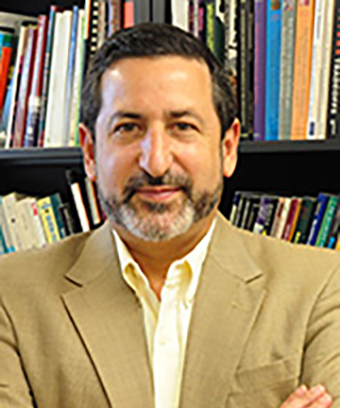Recommendations for the Next U.S. Administration
The task of creating a new vision—and practical strategy—for protecting and strengthening America, is urgent. Here IGCC experts Peter Cowhey, Michael Davidson, Bethany Goldblum, Steven Helfand, Jeannette Money, George Rutherford, and Susan Shirk chart a path for the next U.S. administration on trade policy; climate change; nuclear weapons; global development and aid; migration; COVID-19; and China.

Peter Cowhey on Trade Policy
The strains in the U.S.-China relationship will drive the options for trade policy. Even if we correctly abandon the “tariff wars” associated with the Trump administration negotiations with China, the new U.S. response to China will change the policy mix for international commerce. It will focus on regulatory coordination among like-minded countries and less on the World Trade Organization (WTO) and regional trade agreements even as it tries to avoid doing major damage to the valuable trade rules and market openings that have already been achieved through these trade agreements.
The China centric agenda has three drivers. First, China is the first competitor to the United States that could credibly be its economic equal. (Japan was formidable in its rise but never had the U.S. scale, and the EU is still a quilt, not a single national economy.) The United States still has a scientific and technological edge, and its per capita wealth is much larger, but Washington is right to recognize the closing gap. Second, unlike Japan, China is not a military ally; indeed, it is a strategic rival in several important respects. Third, China has doubled down on state direction of its economy under President Xi; the tools of the WTO are not fully up to responding to this challenge even if they can be useful parts of the policy tool kit.
These circumstances mean that U.S. policy will focus on a strategy to combine major domestic policy measures to boost U.S. competitiveness with more stringent forms of risk management in regard to commerce with China. Tariff wars are not particularly helpful for this approach. Indeed, efforts to boost U.S. technological leadership and damp down risks from continued commercial and scientific ties to China would work better if they catalyzed a new “technology alliance” among countries with sophisticated technologies and similar policy concerns about China. For example, such an alliance could coordinate an agenda of national regulatory measures, such as export licensing and criteria for screening, not banning, Chinese foreign investment. A new technology alliance might also undertake some common initiatives to bolster the diversification of supply chains so as to reduce—not eliminate—reliance on China. U.S. policy should also aim to reduce regulatory barriers to key economic inputs, such as cross-border flows of data among alliance members, while protecting common values about privacy. At the same time, such an alliance would coordinate policies in a manner designed to avoid damaging the basic principles of the WTO and other established trade agreements. This will leave the door open to some future time when China may be willing to negotiate trade and bilateral regulatory agreements that remedy the most serious problems confronting the U.S.-China technology and trade agenda.
Peter Cowhey is dean and Qualcomm endowed chair in Communications and Technology Policy in the School of Global Policy and Strategy at UC San Diego.

Michael Davidson on Climate Change
A U.S. administration serious about addressing climate change faces two strong headwinds, which have emerged since the global climate accord was approved in Paris in 2015. First, the world has emitted a lot of carbon in the last five years, revealing the inadequacy of national commitments; and second, the credibility of the United States to lead on climate has been substantially harmed by four years of obstruction.
Simply rejoining the Paris Agreement is insufficient. At a minimum, the United States must dramatically enhance pledges for 2030 (submissions are due to the United Nations by the end of 2021) and revise its mid-century strategy to achieve net-zero emissions economy-wide by 2050. Beyond pledging to do more, the federal government also needs to back it up with ambitious national mandates—such as a 100 percent clean electricity goal—and serious and sustained public investments along the lines of democratic proposals of $500 billion or more per year—an order of magnitude larger than the $90 billion committed as part of the Recovery Act of 2009, which was the single biggest investment in clean energy by any administration.
Momentum to reach Paris was catalyzed in large part by the joint U.S.-China climate announcement of 2014, between Presidents Obama and Xi, representing 40 percent of global emissions. A successful repeat would now likely require a tripartite agreement that brings in the European Union (EU), which has vastly outpaced the United States and most other countries in terms of ambition—proposing to more than halve emissions by 2030 compared to 1990 levels. The EU has also marshalled the sole diplomatic pressure on China during the U.S. interregnum. The next administration should work across the Atlantic to strengthen ambition from all major emitters.
A new mode of climate cooperation must also encourage innovative cross-border financing partnerships to address the large gap in affordable clean energy abroad. These partnerships would replace current U.S. policy which, among other elements, rejects the Asian Infrastructure Investment Bank because it was proposed by China. They could also help to “green” China’s outbound activities such as the Belt and Road Initiative. This is no time for Cold War-era mentalities with the long-term health of our planet in the balance.
To be successful politically and technologically, climate policy needs to fundamentally embrace industrial policy. What is considered politically acceptable discourse in the United States has rightly evolved, from a carbon pricing-first approach, to one composed of sector-specific standards, investments, research and development, environmental justice, and government procurement, all while protecting the American worker. The risk facing sectoral policies is a potential pendulum shift toward overly protectionist measures that break efficient global supply chains, which are the primary catalyst for precipitous price declines in clean energy enjoyed today by U.S. consumers. Here again, understanding China will be central to a U.S. administration eager to meet ambitious climate goals and create robust U.S. employment. Rather than attempt to wrest control of well-established commodities like China’s crystalline photovoltaics producers, the United States should prioritize “strategically building on areas of U.S. manufacturing strength and identifying future market opportunities where no country has taken the lead,” as called for in the U.S. House Select Committee on the Climate Crisis report earlier this year.
Finally, while technology competition between the United States and China has become increasingly (and perhaps unavoidably) contentious, it is worth reflecting on the fact that clean energy technologies pose far fewer risks to national security than climate change itself. An understanding between the two countries on clean tech trade, difficult as it may be, could help to ensure that every country is able to aggressively deploy low-cost clean technologies in the timeframe required.
Michael Davidson is an assistant professor in the School of Global Policy and Strategy at UC San Diego.

Bethany Goldblum on Nuclear Weapons Policy
In the face of the current COVID-19 public health crisis, the threats posed by nuclear weapons may seem remote. However, nuclear weapons remain an existential threat to humanity.
Moreover, a return to great power competition presents clear risks for international security. The arsenals of the United States and Russia together make up more than 90 percent of the global nuclear stockpile. Whether by accident or aggression, a deterioration of U.S.-Russia relations that leads to a nuclear exchange would be devastating. As a consequence, the goal of reducing nuclear risks is as compelling as ever.
The last major arms control agreement between the U.S. and Russia, New START, is set to expire on February 5, 2021. Following the collapse of the Intermediate-Range Nuclear Forces (INF) Treaty, this is the only remaining agreement that places any limits on the two countries’ nuclear arsenals. It also plays a significant role in supporting the existing nonproliferation regime. Negotiating an extension of New START is the most urgent nuclear issue for the next administration. Although we have the necessary technical tools to continue to verify New START—through cooperative monitoring measures, on-site inspections, and national technical means—the political barriers to extension are significant. Questions as to the appropriateness of China’s involvement given their growing nuclear arsenal, Russian critiques regarding the absence of limits on ballistic missile defense systems, and efforts to include nonstrategic nuclear weapons in the agreement represent just three of many points of contention that would need to be tackled when negotiating a new deal. Extending New START as soon as possible represents our best option for supporting U.S. national security and strategic stability.
There are also three major proliferation concerns that the new administration will have to address: Iran, North Korea, and crisis instability in South Asia. Following the termination of the Iran Deal, we are going to need to find a means to reengage on the deal or come up with a new agreement to make progress there. North Korea has an active and increasingly sophisticated nuclear weapons program and there is currently no framework or timetable for denuclearization. Meanwhile, tensions between India and Pakistan remain high and there is no forum for dialogue. In the face of the impending entry into force of the Treaty on the Prohibition of Nuclear Weapons, frustrations with the pace of nuclear disarmament by parties to the Treaty on the Nonproliferation of Nuclear Weapons (NPT) must be acknowledged—lest the existing NPT regime crumble under these significant differences in perspective. The new administration must prioritize the integrity of the NPT and work to ensure international cooperation in addressing proliferation challenges.
Each of these issues deserves presidential attention.
As a nuclear scientist, I take my policy obligations seriously. While much of my work is technical—applied nuclear physics and radiation detection—I also have the opportunity to collaborate with students and postdocs, to develop the workforce and build the expertise needed to support the nuclear enterprise and nonproliferation initiatives. As Bill Perry said in his book, “the key to taking constructive actions that can prevent nuclear weapons from ever being used again is education.” It is critical to keep early career scholars engaged. This is why educational initiatives, like the Nuclear Science and Security Consortium, are so important. The Public Policy and Nuclear Threats Boot Camp, a workshop at the UC Institute on Global Conflict and Cooperation offers an exemplary model, giving scholars and practitioners the tools they need to address ongoing nuclear and national security challenges.
Bethany Goldblum is a member of the research faculty in the Department of Nuclear Engineering at UC Berkeley, and the founder and director of the Nuclear Policy Working Group.

Steven Helfand on Global Development and Aid
Poverty in developing countries is not a problem that the United States alone can solve, nor can it be eliminated solely with aid. To be effective, the next U.S. administration must work on multiple fronts, collaborate with partners, and prioritize its efforts. It should make decisions based on evidence, and strive for actions with large multiplier effects. Multipliers are achieved when actions crowd in partners and investments, reduce current poverty while addressing the causes of future poverty, and achieve multiple objectives with a single initiative.
The most immediate priority for the next administration should be to address the impacts of COVID-19 on poor people in developing countries and ensure rapid and equitable access to a vaccine once it becomes available. Health shocks affect the poor and vulnerable disproportionately, drive households into poverty, and can have lifetime impacts on children through inadequate nutrition and insufficient education. Collaboration will be essential—the United States will need to work with international partners such as the World Health Organization and the Bill & Melinda Gates Foundation.
Conditional cash transfers (CCTs) have been one of the most effective policies in the 21st century for reducing current and future poverty in developing countries. CCTs transfer cash to poor families subject to certain conditions normally related to the health and education of the children, such as vaccinations, visits to health clinics, and school attendance. These policies have been carried out by governments throughout the developing world, and there is strong evidence demonstrating their effectiveness. CCTs work better where the supply of educational and health services is sufficient, both in terms of quantity and quality. The next administration could have a big impact on poverty in the present and future by working with developing countries to improve children’s access to healthcare and education.
A high proportion of the poor in developing countries live in rural areas and work in agriculture. Increased agricultural productivity in developing countries—which contributes to higher incomes—should be an important component of the next administration’s strategy for attacking global poverty. The evidence is clear that education contributes to the adoption of new technologies and increased productivity. Improvements in rural education also provide children with the opportunity, later in life, to seek employment in other sectors of the economy if they so choose. Beyond education, increased productivity can be achieved via support for the adoption of higher yielding or drought resistant varieties, and through fertilizer subsidies and the provision of plot-specific information about how fertilizer should be used. Policy options also include institutional support for index-insurance schemes that protect farmers against droughts and floods and incentivize investments that contribute to higher productivity and income.
Finally, one of the highest priorities for the next administration should be to focus its development efforts on the countries of Central America. There is a humanitarian crisis taking place in the region, and it spills over to the United States in the form of caravans of refugees, and thousands of people seeking asylum or crossing the border as undocumented immigrants. The underlying drivers of the crisis are complex, including drugs and violence, inequality, authoritarian governments, and climate change. While calls for a Marshall Plan for the region correctly focus attention on the gravity of the problem and the scale of the required response, what worked for Europe in 1948 is not what is likely to work in Central America in 2021.
Central American countries require much more than a massive injection of foreign resources. They need assistance in strengthening democratic institutions and in combatting drugs and violence. In terms of poverty and development, the policies described above—with a focus on children, health and education, COVID-19, and agricultural productivity—provide a valuable point of departure. So too could enhanced remittances. In Guatemala and El Salvador, for example, remittances represented between 13 percent and 21 percent of GDP in 2019. This volume of resources was around ten times larger than foreign direct investment, twenty times larger than foreign aid, and 75 percent of the value of exports. The benefits of remittances also tend to be widely distributed, with a disproportionate share going to poor households. The next administration should seek to grow the flow of remittances to Central America. This could be achieved through a redesigned guest worker program with enhanced rights and protections. Policies that contribute to lowering the cost of sending money home could also play a role.
Steven Helfand professor and chair of Economics at the University of California, Riverside.

Jeannette Money on Migration
The world’s more than 272 million migrants confront greater vulnerabilities in the wake of the COVID-19 pandemic. As a recent UN report notes, the pandemic exacerbates the risks migrants face, creating a health crisis, a socio-economic crisis stemming from loss of employment, and a protection crisis for asylum seekers turned away at international borders. Although migration represents only 3.5 percent of the global population, migration pressures show no signs of slowing: the number of international migrants has increased significantly faster (78 percent) than the global population (45 percent) since 1990, according to the United Nations (United Nations 2019).
U.S. policy towards migrants has shifted in several significant ways under the Trump administration. Rhetorically, Trump uses migration as a divisive tool—maligning migrants as criminals and rapists. Though the Obama administration deported more migrants than any previous administration, the Trump administration’s deportation policy is much more arbitrary. Previously, only those who were convicted of serious crimes faced deportation. Now, everyone is vulnerable. The result is a much more insecure migrant community.
The Trump administration has also changed protections for asylum seekers and refugees. The ceiling for refugee resettlement for the 2020 was set at 18,000 and the US resettled only 11,814 refugees during the 2020 fiscal year, the lowest number of refugees since 1980, when Congress created the nation’s refugee resettlement program. Asylum seekers have also been affected. In early 2019, the Trump administration began limiting the number of asylum applications that could be filed each day and requiring asylum seekers to wait in Mexico while their asylum claims were processed (the so-called Migrant Protection Protocols). With the advent of COVID-19, border controls restrict the acceptance of new asylum claims. Preventing asylum seekers from lodging their claims contravenes our international obligations under the UN Convention on the Status of Refugees, and our own asylum laws and legal norms. The Trump administration also, notably, suspended DACA, Deferred Action for Childhood Arrivals.
Migrants are good for the United States—they strengthen our economy and support for them reflects our values and commitments as a responsible member of the global community. The next U.S. administration should prioritize four policies:
First, during the pandemic, we need to treat migrants, even unauthorized migrants, the same as citizens. People on the move are less able to protect themselves because they often face crowded, unsanitary living or working conditions, and have less access to health services. Amid the global pandemic, migrants in the United States are often front line workers, harvesting our crops, packaging our food, and caring for our sick, among other things. But increased exposure to the novel coronavirus in migrant communities puts everyone at risk. The U.S. federal and state governments need to ensure that migrant workplaces are safe, and that migrant communities have access to health care and to adequate resources while they stay at home if they are sick or need to quarantine. We must treat migrants like citizens because their well-being affects our well-being. In the words of the United Nations, “no one is safe unless everyone is safe.”
The second priority is DACA. The Trump administration’s decision to rescind DACA was overruled by a recent Supreme Court decision but is likely to be contested if Trump is reelected. We are better off as a country if we allow the decision to stand and re-open enrollment to young people and grant them the documented status that permits them to be productive members of our community. Large majorities of Americans support giving legal status to immigrants who were brought into the country as children. Extending and expanding DACA clearly benefits the migrants themselves, but it also benefits the United States. They cannot make the contributions they otherwise would without coming out the shadows.
Third, the United States should reverse current policies affecting refugees and asylum seekers. We need to ensure that our values are reflected in our policies. We have a moral, as well as a legal, obligation to welcome refugees and adjudicate asylum claims on our soil. We need to expand our refugee acceptance ceiling to higher levels and, to ensure that asylum claims are quickly and fairly adjudicated, we need to marshal the necessary resources. The Migrant Protection Protocols, which require asylum seekers to stay in Mexico, should be rescinded and asylum seekers allowed to enter and stay in the United States while their claims are processed.
The fourth priority is to address the broader issue of the undocumented population in the United States. Even though the “Dreamers”—young people eligible for DACA—may now gain assurances of their legal status, they are only a small portion of the more than 10 million unauthorized migrants in the United States. Deportation is not a viable solution. Two-thirds of these immigrants have lived in the United States for more than 10 years. They work, buy homes, send their children to school, and pay taxes; they are part of our communities. The next administration need to lead a reasoned debate about how to secure the lives of our immigrant neighbors.
Smart migration policies and protection for the vulnerable are part of the fabric of U.S. history, support U.S. interests, and reflect U.S. values. The next administration has an opportunity to lead in this space—a task the COVID-19 pandemic has made all the more urgent.
Jeannette Money is a professor in the Political Science Department at the University of California, Davis.

George Rutherford on COVID-19 Response
The COVID-19 pandemic is one of the great public health challenges of our time. Because of the wide-ranging effects of the disease, and because COVID-19 spreads in communities among asymptomatic infected people, it is a much more serious disease than SARS or MERS, which, despite having a higher mortality rate, spread mainly in hospitals and were much easier to contain.
The first priority for the next administration must be a vaccine stratetegy—that must be in place well before they take office. The next administration will have to determine how much vaccine is available, how it is going to be distributed, and who is going to get it first. That is by far the biggest and first task.
The second priority should be helping our neighbors, particularly big trading partners such as Mexico and Canada. We need to work with them to help develop a strategy for helping them get this under control. Beyond our immediate neighbors, there are a number of bridges that need to be repaired around the world.
There are several other areas of domestic concern. Take farm workers. That’s where much of the disease is now. The next administration will need to support states to balance the nation’s need for crops with the need to contain spread of the disease and protect farm workers. Along the same lines, we will need to tackle the challenge of burgeoning disease spread in meat packing plants, fruit packing plants, manufacturing plants, and prisons. Another area is how to adapt the education sector—when and where can schools reopen and how do you enforce protocols to ensure students, teachers, janitorial staff and families are protected? Internationally, we also need to support low- and middle-income countries—where the United States has long played a positive, supportive role in health—to tackle the pandemic. And we need, without question, to cancel the ill-conceived plan to exit the World Health Organization.
The next administration will also need to take a big step back and ensure a viable plan is in place for when this happens again. There at least three other beta coronaviruses circulating in bats in southern China that could do the same thing as SARS-CoV-2. Under the Trump administration, the U.S. Agency for International Development killed its surveillance programs in Hubei province, which is where Wuhan is, in October. We need surveillance. We need to be able to distribute vaccines. We need to understand how much vaccine you need and how frequently you need it whether we need to reformulate it. And we need to determine how we are going to secure the borders by helping countries that surround us control their epidemic.
More than anything the next adminsitration must exhibit leadership. Under the Constitution, public health is under the purview of the states; however, national and international leadership are desperately needed for a pandemic, whose scope—both in terms of death and in terms of our economy—are of historic scale.
George Rutherford is Salvatore Pablo Lucia professor and the head of the Division of Infectious Disease and Global Epidemiology at the School of Medicine at UC San Francisco.

Susan Shirk on U.S.-China Policy
U.S.-China relations are more hostile today than they have been in the entire post-Mao era—worse even than the period after the 1989 Tiananmen crackdown.
In both countries, there is a debate about why relations have soured so badly. My own view is that it began in the mid-2000s when the Chinese government shifted its foreign and domestic policies. Up to that time, as China grew stronger—militarily, economically, and diplomatically—it sought to reassure other countries that it was not a threat, and that its intentions were benign. The Chinese leadership had a sophisticated understanding that, like any rising power, it was bound to be perceived as a threat. To counter that view it adopted a strategy of reassurance.
But in the mid-2000s, the Chinese government started over-reaching internationally, hyping international threats, and bullying other countries, especially in the South China Sea. It also started over-reaching domestically to preserve social stability by cracking down on the media and civil society. Some blame these policy shifts on the 2008 global financial crisis, but many of these behavioral changes started before then. The global financial crisis did, however, create a triumphalism in China and a demand for an even tougher foreign policy, which also contributed to this overreaching.
When Xi Jinping came to power, his foreign policy was even more ambitious and assertive, and at home, he exerted even tighter social and ideological control. He also violated the norms of peaceful turnover of top leadership by failing to appoint an heir apparent and changing the constitution to allow him more than two terms. These actions sparked a backlash, not just in the United States, but in other countries as well.
The Trump administration adopted sledgehammer approach: confronting China on every continent, on every domain, without any clear communication about United States objectives, and no effort to negotiate the issues under dispute. As a result, we have failed to influence China’s policies for the better and have completely alienated not only the Chinese government, but also the Chinese people by acting in such a hostile manner towards China.
The next administration needs a better approach. The most urgent challenge is to find a way to cooperate on the COVID-19 pandemic. If the United States and China continue to operate at cross purposes as they are now, it will make it extremely difficult for the rest of the world to organize collective action in the distribution of vaccines and therapeutics, as well as to prepare for the next pandemic. In the past, despite our disputes with China, the United States managed to cooperate on public health. COVID-19 has shown just how bad relations have become because almost no cooperation whatsoever is happening. The first order of business is to save lives by working together on COVID-19.
The next agenda item is to set priorities. We must decide what Chinese policies and behaviors we find the most negative from the standpoint of U.S interests and values, and which might be amenable to change. There are some things we are unlikely to change, regardless of the policy instrument used, especially issues related to sovereignty, such as Hong Kong, and the treatment of the Muslim population in Xinjiang. Anything related to domestic social control is very difficult to change by external pressure.
There are other areas, however, especially related to economic policy, where we have some leverage. Some of the things that we would like to do in terms of leveling the playing field in China for our companies, for example, would also be very popular with the private businesses in China that feel discriminated against. Our economic policy should use smart diplomacy and carrots and sticks to drive change.
In foreign policy, in conjunction with Asian allies and friends, we could make progress on the South China Sea and relations with Japan. We need smart diplomacy, including pressure as well as reassurance. And we need to take a more practical—and less ideological—approach with China.
Over the past four years, the United States alienated a lot of our friends and allies with a go-it-alone, America First approach. A very urgent matter is to mend fences, and hope that our allies will forgive us the aberration of the last four years—because we need to work together with other countries if we want to influence China’s actions.
Finally, tackling the challenge of China requires us to strengthen ourselves at home. We need to increase our investment in education and research, and we need to build infrastructure. In many ways, a domestic focus to recover from the pandemic and revive America’s strengths is probably the best foreign policy. Right now, many in China are busy celebrating the superiority of the Chinese political and economic system. We need to prove that our system is better—for our own citizens, and the world.
Susan Shirk, director emeritus of the UC Institute on Global Conflict and Cooperation, is research professor in the School of Global Policy and Strategy at UC San Diego and chair of the 21st Century China Center.